Acute Nursing: Post-Adrenalectomy Care Plan for Cushing’s Syndrome
VerifiedAdded on 2023/06/14
|6
|2274
|418
Case Study
AI Summary
This case study focuses on Susan Summers, a 40-year-old female with Cushing's syndrome due to an adrenal gland tumor, who undergoes a laparoscopic right adrenalectomy. The solution addresses the etiology and pathophysiology of Cushing's syndrome, detailing how excessive cortisol production impacts various bodily systems. It further explores potential post-operative deterioration following adrenalectomy, including adrenal insufficiency, electrolyte imbalances, and cardiovascular complications. The nursing management section outlines critical care interventions, such as monitoring vital signs, managing pain, preventing infection, and administering cortisol to address adrenal insufficiency. Finally, it highlights the roles of care managers, pharmacists, and diagnostic test technicians in Susan's comprehensive care, emphasizing their contributions to care coordination, medication management, and accurate diagnostics. Desklib offers a wealth of resources for students, including past papers and solved assignments.
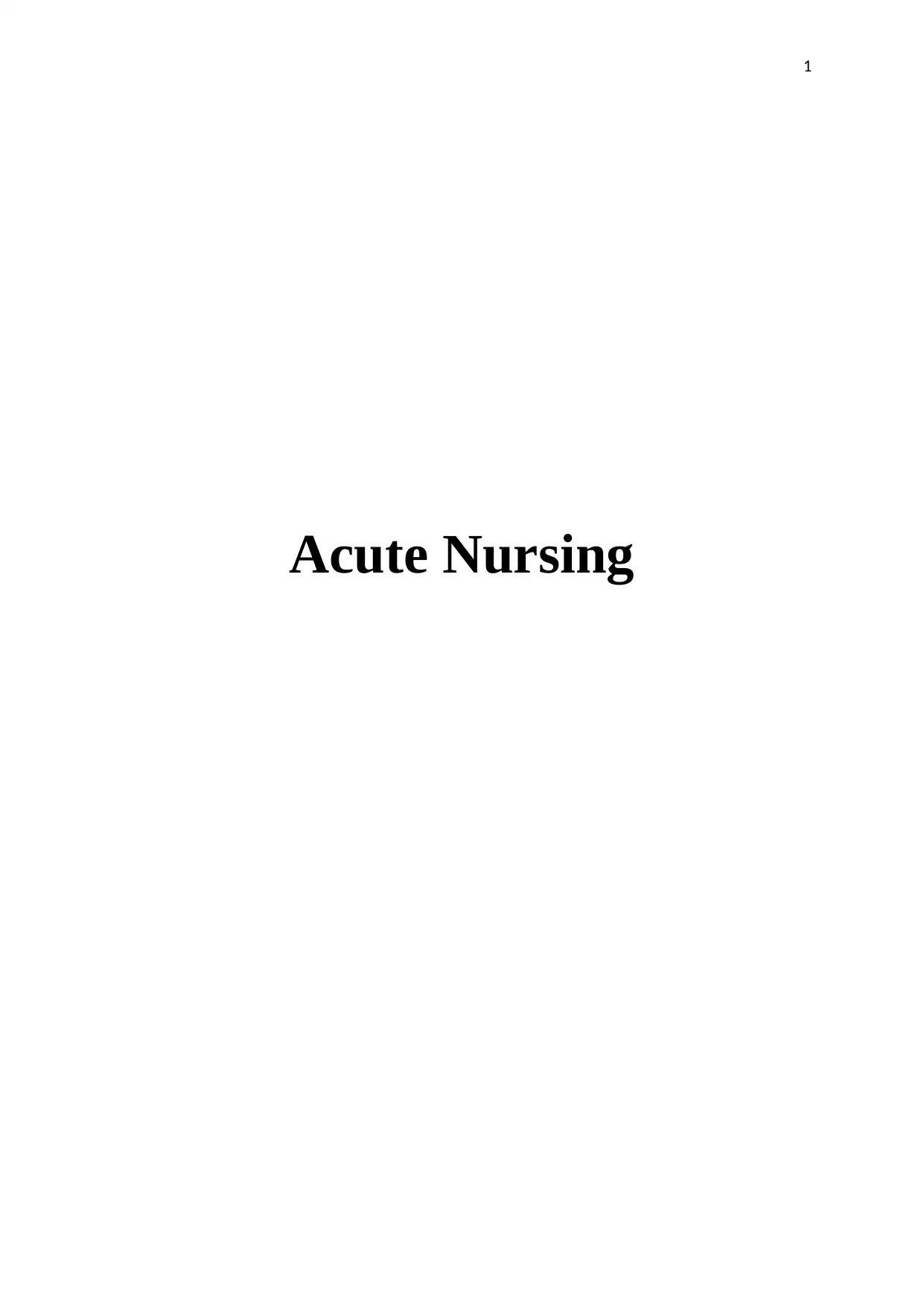
1
Acute Nursing
Acute Nursing
Paraphrase This Document
Need a fresh take? Get an instant paraphrase of this document with our AI Paraphraser
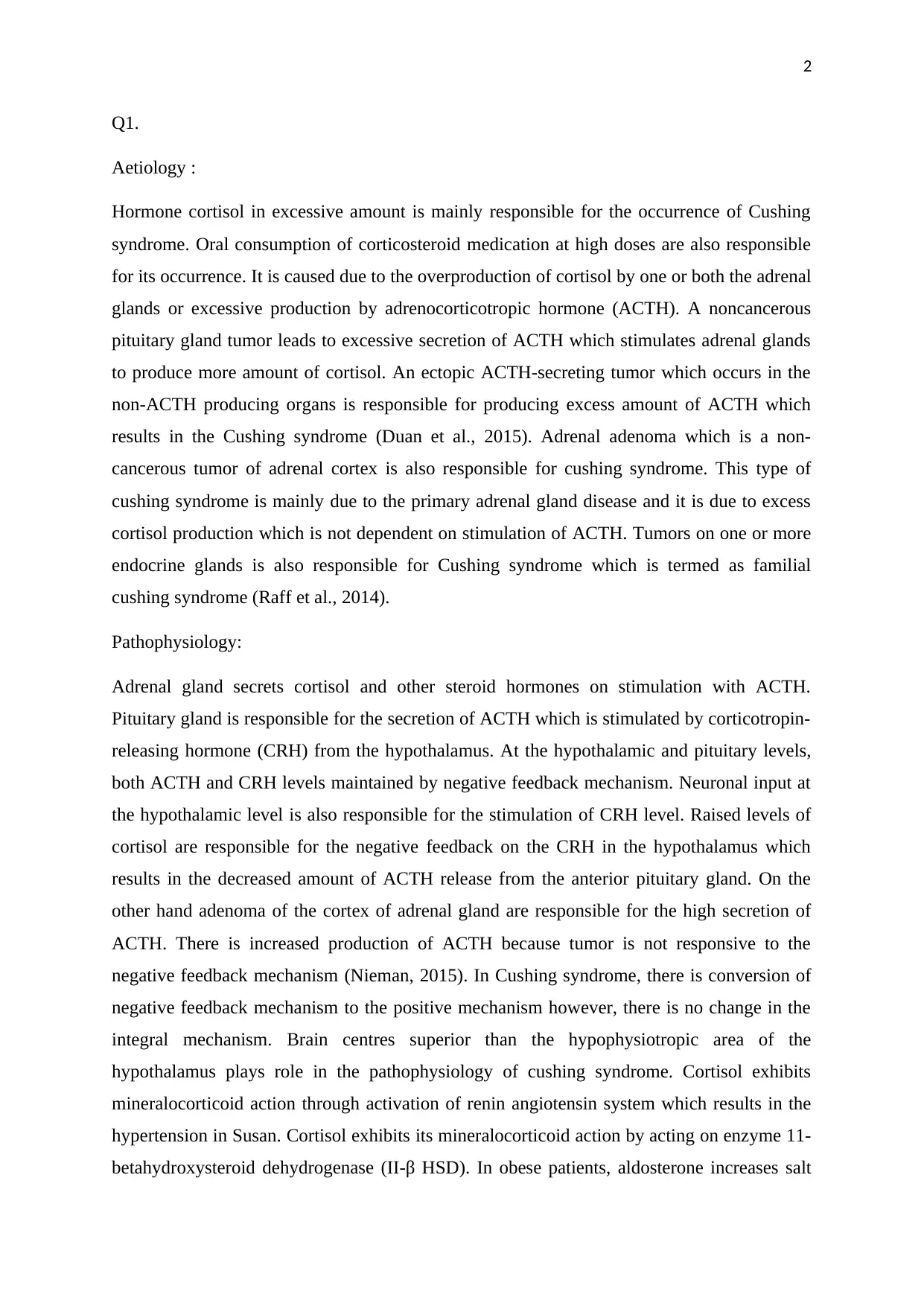
2
Q1.
Aetiology :
Hormone cortisol in excessive amount is mainly responsible for the occurrence of Cushing
syndrome. Oral consumption of corticosteroid medication at high doses are also responsible
for its occurrence. It is caused due to the overproduction of cortisol by one or both the adrenal
glands or excessive production by adrenocorticotropic hormone (ACTH). A noncancerous
pituitary gland tumor leads to excessive secretion of ACTH which stimulates adrenal glands
to produce more amount of cortisol. An ectopic ACTH-secreting tumor which occurs in the
non-ACTH producing organs is responsible for producing excess amount of ACTH which
results in the Cushing syndrome (Duan et al., 2015). Adrenal adenoma which is a non-
cancerous tumor of adrenal cortex is also responsible for cushing syndrome. This type of
cushing syndrome is mainly due to the primary adrenal gland disease and it is due to excess
cortisol production which is not dependent on stimulation of ACTH. Tumors on one or more
endocrine glands is also responsible for Cushing syndrome which is termed as familial
cushing syndrome (Raff et al., 2014).
Pathophysiology:
Adrenal gland secrets cortisol and other steroid hormones on stimulation with ACTH.
Pituitary gland is responsible for the secretion of ACTH which is stimulated by corticotropin-
releasing hormone (CRH) from the hypothalamus. At the hypothalamic and pituitary levels,
both ACTH and CRH levels maintained by negative feedback mechanism. Neuronal input at
the hypothalamic level is also responsible for the stimulation of CRH level. Raised levels of
cortisol are responsible for the negative feedback on the CRH in the hypothalamus which
results in the decreased amount of ACTH release from the anterior pituitary gland. On the
other hand adenoma of the cortex of adrenal gland are responsible for the high secretion of
ACTH. There is increased production of ACTH because tumor is not responsive to the
negative feedback mechanism (Nieman, 2015). In Cushing syndrome, there is conversion of
negative feedback mechanism to the positive mechanism however, there is no change in the
integral mechanism. Brain centres superior than the hypophysiotropic area of the
hypothalamus plays role in the pathophysiology of cushing syndrome. Cortisol exhibits
mineralocorticoid action through activation of renin angiotensin system which results in the
hypertension in Susan. Cortisol exhibits its mineralocorticoid action by acting on enzyme 11-
betahydroxysteroid dehydrogenase (II-β HSD). In obese patients, aldosterone increases salt
Q1.
Aetiology :
Hormone cortisol in excessive amount is mainly responsible for the occurrence of Cushing
syndrome. Oral consumption of corticosteroid medication at high doses are also responsible
for its occurrence. It is caused due to the overproduction of cortisol by one or both the adrenal
glands or excessive production by adrenocorticotropic hormone (ACTH). A noncancerous
pituitary gland tumor leads to excessive secretion of ACTH which stimulates adrenal glands
to produce more amount of cortisol. An ectopic ACTH-secreting tumor which occurs in the
non-ACTH producing organs is responsible for producing excess amount of ACTH which
results in the Cushing syndrome (Duan et al., 2015). Adrenal adenoma which is a non-
cancerous tumor of adrenal cortex is also responsible for cushing syndrome. This type of
cushing syndrome is mainly due to the primary adrenal gland disease and it is due to excess
cortisol production which is not dependent on stimulation of ACTH. Tumors on one or more
endocrine glands is also responsible for Cushing syndrome which is termed as familial
cushing syndrome (Raff et al., 2014).
Pathophysiology:
Adrenal gland secrets cortisol and other steroid hormones on stimulation with ACTH.
Pituitary gland is responsible for the secretion of ACTH which is stimulated by corticotropin-
releasing hormone (CRH) from the hypothalamus. At the hypothalamic and pituitary levels,
both ACTH and CRH levels maintained by negative feedback mechanism. Neuronal input at
the hypothalamic level is also responsible for the stimulation of CRH level. Raised levels of
cortisol are responsible for the negative feedback on the CRH in the hypothalamus which
results in the decreased amount of ACTH release from the anterior pituitary gland. On the
other hand adenoma of the cortex of adrenal gland are responsible for the high secretion of
ACTH. There is increased production of ACTH because tumor is not responsive to the
negative feedback mechanism (Nieman, 2015). In Cushing syndrome, there is conversion of
negative feedback mechanism to the positive mechanism however, there is no change in the
integral mechanism. Brain centres superior than the hypophysiotropic area of the
hypothalamus plays role in the pathophysiology of cushing syndrome. Cortisol exhibits
mineralocorticoid action through activation of renin angiotensin system which results in the
hypertension in Susan. Cortisol exhibits its mineralocorticoid action by acting on enzyme 11-
betahydroxysteroid dehydrogenase (II-β HSD). In obese patients, aldosterone increases salt
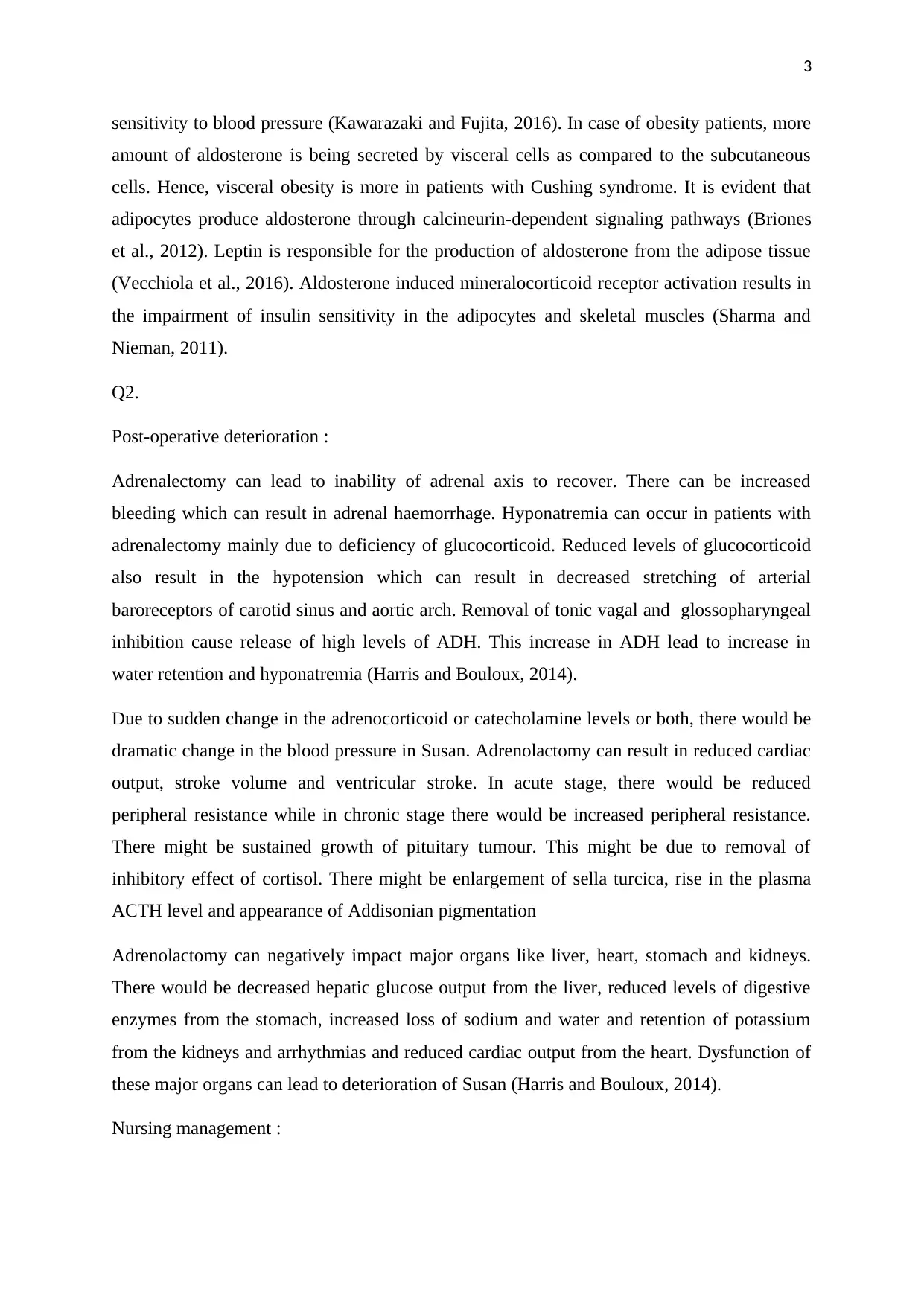
3
sensitivity to blood pressure (Kawarazaki and Fujita, 2016). In case of obesity patients, more
amount of aldosterone is being secreted by visceral cells as compared to the subcutaneous
cells. Hence, visceral obesity is more in patients with Cushing syndrome. It is evident that
adipocytes produce aldosterone through calcineurin-dependent signaling pathways (Briones
et al., 2012). Leptin is responsible for the production of aldosterone from the adipose tissue
(Vecchiola et al., 2016). Aldosterone induced mineralocorticoid receptor activation results in
the impairment of insulin sensitivity in the adipocytes and skeletal muscles (Sharma and
Nieman, 2011).
Q2.
Post-operative deterioration :
Adrenalectomy can lead to inability of adrenal axis to recover. There can be increased
bleeding which can result in adrenal haemorrhage. Hyponatremia can occur in patients with
adrenalectomy mainly due to deficiency of glucocorticoid. Reduced levels of glucocorticoid
also result in the hypotension which can result in decreased stretching of arterial
baroreceptors of carotid sinus and aortic arch. Removal of tonic vagal and glossopharyngeal
inhibition cause release of high levels of ADH. This increase in ADH lead to increase in
water retention and hyponatremia (Harris and Bouloux, 2014).
Due to sudden change in the adrenocorticoid or catecholamine levels or both, there would be
dramatic change in the blood pressure in Susan. Adrenolactomy can result in reduced cardiac
output, stroke volume and ventricular stroke. In acute stage, there would be reduced
peripheral resistance while in chronic stage there would be increased peripheral resistance.
There might be sustained growth of pituitary tumour. This might be due to removal of
inhibitory effect of cortisol. There might be enlargement of sella turcica, rise in the plasma
ACTH level and appearance of Addisonian pigmentation
Adrenolactomy can negatively impact major organs like liver, heart, stomach and kidneys.
There would be decreased hepatic glucose output from the liver, reduced levels of digestive
enzymes from the stomach, increased loss of sodium and water and retention of potassium
from the kidneys and arrhythmias and reduced cardiac output from the heart. Dysfunction of
these major organs can lead to deterioration of Susan (Harris and Bouloux, 2014).
Nursing management :
sensitivity to blood pressure (Kawarazaki and Fujita, 2016). In case of obesity patients, more
amount of aldosterone is being secreted by visceral cells as compared to the subcutaneous
cells. Hence, visceral obesity is more in patients with Cushing syndrome. It is evident that
adipocytes produce aldosterone through calcineurin-dependent signaling pathways (Briones
et al., 2012). Leptin is responsible for the production of aldosterone from the adipose tissue
(Vecchiola et al., 2016). Aldosterone induced mineralocorticoid receptor activation results in
the impairment of insulin sensitivity in the adipocytes and skeletal muscles (Sharma and
Nieman, 2011).
Q2.
Post-operative deterioration :
Adrenalectomy can lead to inability of adrenal axis to recover. There can be increased
bleeding which can result in adrenal haemorrhage. Hyponatremia can occur in patients with
adrenalectomy mainly due to deficiency of glucocorticoid. Reduced levels of glucocorticoid
also result in the hypotension which can result in decreased stretching of arterial
baroreceptors of carotid sinus and aortic arch. Removal of tonic vagal and glossopharyngeal
inhibition cause release of high levels of ADH. This increase in ADH lead to increase in
water retention and hyponatremia (Harris and Bouloux, 2014).
Due to sudden change in the adrenocorticoid or catecholamine levels or both, there would be
dramatic change in the blood pressure in Susan. Adrenolactomy can result in reduced cardiac
output, stroke volume and ventricular stroke. In acute stage, there would be reduced
peripheral resistance while in chronic stage there would be increased peripheral resistance.
There might be sustained growth of pituitary tumour. This might be due to removal of
inhibitory effect of cortisol. There might be enlargement of sella turcica, rise in the plasma
ACTH level and appearance of Addisonian pigmentation
Adrenolactomy can negatively impact major organs like liver, heart, stomach and kidneys.
There would be decreased hepatic glucose output from the liver, reduced levels of digestive
enzymes from the stomach, increased loss of sodium and water and retention of potassium
from the kidneys and arrhythmias and reduced cardiac output from the heart. Dysfunction of
these major organs can lead to deterioration of Susan (Harris and Bouloux, 2014).
Nursing management :
⊘ This is a preview!⊘
Do you want full access?
Subscribe today to unlock all pages.

Trusted by 1+ million students worldwide
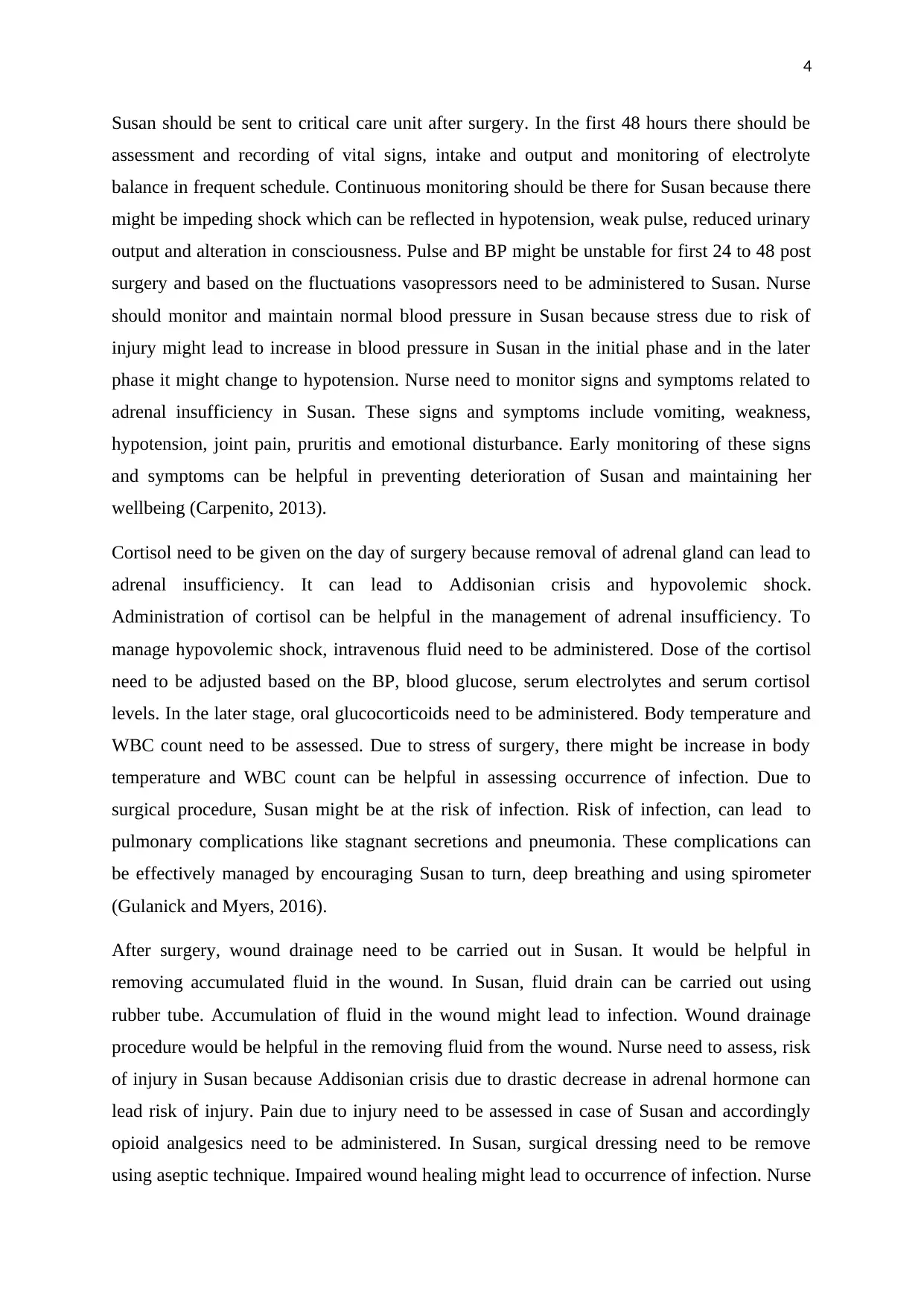
4
Susan should be sent to critical care unit after surgery. In the first 48 hours there should be
assessment and recording of vital signs, intake and output and monitoring of electrolyte
balance in frequent schedule. Continuous monitoring should be there for Susan because there
might be impeding shock which can be reflected in hypotension, weak pulse, reduced urinary
output and alteration in consciousness. Pulse and BP might be unstable for first 24 to 48 post
surgery and based on the fluctuations vasopressors need to be administered to Susan. Nurse
should monitor and maintain normal blood pressure in Susan because stress due to risk of
injury might lead to increase in blood pressure in Susan in the initial phase and in the later
phase it might change to hypotension. Nurse need to monitor signs and symptoms related to
adrenal insufficiency in Susan. These signs and symptoms include vomiting, weakness,
hypotension, joint pain, pruritis and emotional disturbance. Early monitoring of these signs
and symptoms can be helpful in preventing deterioration of Susan and maintaining her
wellbeing (Carpenito, 2013).
Cortisol need to be given on the day of surgery because removal of adrenal gland can lead to
adrenal insufficiency. It can lead to Addisonian crisis and hypovolemic shock.
Administration of cortisol can be helpful in the management of adrenal insufficiency. To
manage hypovolemic shock, intravenous fluid need to be administered. Dose of the cortisol
need to be adjusted based on the BP, blood glucose, serum electrolytes and serum cortisol
levels. In the later stage, oral glucocorticoids need to be administered. Body temperature and
WBC count need to be assessed. Due to stress of surgery, there might be increase in body
temperature and WBC count can be helpful in assessing occurrence of infection. Due to
surgical procedure, Susan might be at the risk of infection. Risk of infection, can lead to
pulmonary complications like stagnant secretions and pneumonia. These complications can
be effectively managed by encouraging Susan to turn, deep breathing and using spirometer
(Gulanick and Myers, 2016).
After surgery, wound drainage need to be carried out in Susan. It would be helpful in
removing accumulated fluid in the wound. In Susan, fluid drain can be carried out using
rubber tube. Accumulation of fluid in the wound might lead to infection. Wound drainage
procedure would be helpful in the removing fluid from the wound. Nurse need to assess, risk
of injury in Susan because Addisonian crisis due to drastic decrease in adrenal hormone can
lead risk of injury. Pain due to injury need to be assessed in case of Susan and accordingly
opioid analgesics need to be administered. In Susan, surgical dressing need to be remove
using aseptic technique. Impaired wound healing might lead to occurrence of infection. Nurse
Susan should be sent to critical care unit after surgery. In the first 48 hours there should be
assessment and recording of vital signs, intake and output and monitoring of electrolyte
balance in frequent schedule. Continuous monitoring should be there for Susan because there
might be impeding shock which can be reflected in hypotension, weak pulse, reduced urinary
output and alteration in consciousness. Pulse and BP might be unstable for first 24 to 48 post
surgery and based on the fluctuations vasopressors need to be administered to Susan. Nurse
should monitor and maintain normal blood pressure in Susan because stress due to risk of
injury might lead to increase in blood pressure in Susan in the initial phase and in the later
phase it might change to hypotension. Nurse need to monitor signs and symptoms related to
adrenal insufficiency in Susan. These signs and symptoms include vomiting, weakness,
hypotension, joint pain, pruritis and emotional disturbance. Early monitoring of these signs
and symptoms can be helpful in preventing deterioration of Susan and maintaining her
wellbeing (Carpenito, 2013).
Cortisol need to be given on the day of surgery because removal of adrenal gland can lead to
adrenal insufficiency. It can lead to Addisonian crisis and hypovolemic shock.
Administration of cortisol can be helpful in the management of adrenal insufficiency. To
manage hypovolemic shock, intravenous fluid need to be administered. Dose of the cortisol
need to be adjusted based on the BP, blood glucose, serum electrolytes and serum cortisol
levels. In the later stage, oral glucocorticoids need to be administered. Body temperature and
WBC count need to be assessed. Due to stress of surgery, there might be increase in body
temperature and WBC count can be helpful in assessing occurrence of infection. Due to
surgical procedure, Susan might be at the risk of infection. Risk of infection, can lead to
pulmonary complications like stagnant secretions and pneumonia. These complications can
be effectively managed by encouraging Susan to turn, deep breathing and using spirometer
(Gulanick and Myers, 2016).
After surgery, wound drainage need to be carried out in Susan. It would be helpful in
removing accumulated fluid in the wound. In Susan, fluid drain can be carried out using
rubber tube. Accumulation of fluid in the wound might lead to infection. Wound drainage
procedure would be helpful in the removing fluid from the wound. Nurse need to assess, risk
of injury in Susan because Addisonian crisis due to drastic decrease in adrenal hormone can
lead risk of injury. Pain due to injury need to be assessed in case of Susan and accordingly
opioid analgesics need to be administered. In Susan, surgical dressing need to be remove
using aseptic technique. Impaired wound healing might lead to occurrence of infection. Nurse
Paraphrase This Document
Need a fresh take? Get an instant paraphrase of this document with our AI Paraphraser
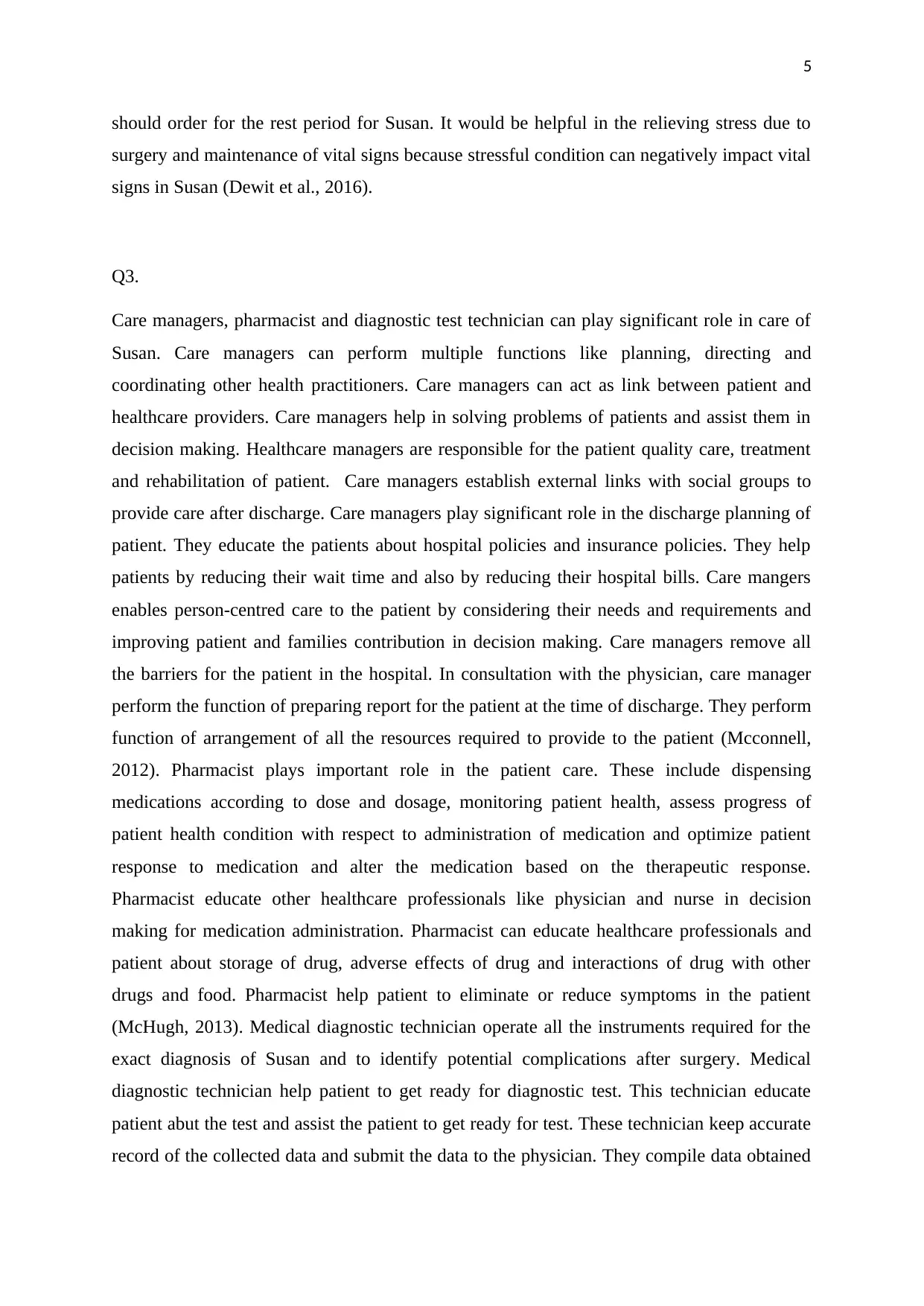
5
should order for the rest period for Susan. It would be helpful in the relieving stress due to
surgery and maintenance of vital signs because stressful condition can negatively impact vital
signs in Susan (Dewit et al., 2016).
Q3.
Care managers, pharmacist and diagnostic test technician can play significant role in care of
Susan. Care managers can perform multiple functions like planning, directing and
coordinating other health practitioners. Care managers can act as link between patient and
healthcare providers. Care managers help in solving problems of patients and assist them in
decision making. Healthcare managers are responsible for the patient quality care, treatment
and rehabilitation of patient. Care managers establish external links with social groups to
provide care after discharge. Care managers play significant role in the discharge planning of
patient. They educate the patients about hospital policies and insurance policies. They help
patients by reducing their wait time and also by reducing their hospital bills. Care mangers
enables person-centred care to the patient by considering their needs and requirements and
improving patient and families contribution in decision making. Care managers remove all
the barriers for the patient in the hospital. In consultation with the physician, care manager
perform the function of preparing report for the patient at the time of discharge. They perform
function of arrangement of all the resources required to provide to the patient (Mcconnell,
2012). Pharmacist plays important role in the patient care. These include dispensing
medications according to dose and dosage, monitoring patient health, assess progress of
patient health condition with respect to administration of medication and optimize patient
response to medication and alter the medication based on the therapeutic response.
Pharmacist educate other healthcare professionals like physician and nurse in decision
making for medication administration. Pharmacist can educate healthcare professionals and
patient about storage of drug, adverse effects of drug and interactions of drug with other
drugs and food. Pharmacist help patient to eliminate or reduce symptoms in the patient
(McHugh, 2013). Medical diagnostic technician operate all the instruments required for the
exact diagnosis of Susan and to identify potential complications after surgery. Medical
diagnostic technician help patient to get ready for diagnostic test. This technician educate
patient abut the test and assist the patient to get ready for test. These technician keep accurate
record of the collected data and submit the data to the physician. They compile data obtained
should order for the rest period for Susan. It would be helpful in the relieving stress due to
surgery and maintenance of vital signs because stressful condition can negatively impact vital
signs in Susan (Dewit et al., 2016).
Q3.
Care managers, pharmacist and diagnostic test technician can play significant role in care of
Susan. Care managers can perform multiple functions like planning, directing and
coordinating other health practitioners. Care managers can act as link between patient and
healthcare providers. Care managers help in solving problems of patients and assist them in
decision making. Healthcare managers are responsible for the patient quality care, treatment
and rehabilitation of patient. Care managers establish external links with social groups to
provide care after discharge. Care managers play significant role in the discharge planning of
patient. They educate the patients about hospital policies and insurance policies. They help
patients by reducing their wait time and also by reducing their hospital bills. Care mangers
enables person-centred care to the patient by considering their needs and requirements and
improving patient and families contribution in decision making. Care managers remove all
the barriers for the patient in the hospital. In consultation with the physician, care manager
perform the function of preparing report for the patient at the time of discharge. They perform
function of arrangement of all the resources required to provide to the patient (Mcconnell,
2012). Pharmacist plays important role in the patient care. These include dispensing
medications according to dose and dosage, monitoring patient health, assess progress of
patient health condition with respect to administration of medication and optimize patient
response to medication and alter the medication based on the therapeutic response.
Pharmacist educate other healthcare professionals like physician and nurse in decision
making for medication administration. Pharmacist can educate healthcare professionals and
patient about storage of drug, adverse effects of drug and interactions of drug with other
drugs and food. Pharmacist help patient to eliminate or reduce symptoms in the patient
(McHugh, 2013). Medical diagnostic technician operate all the instruments required for the
exact diagnosis of Susan and to identify potential complications after surgery. Medical
diagnostic technician help patient to get ready for diagnostic test. This technician educate
patient abut the test and assist the patient to get ready for test. These technician keep accurate
record of the collected data and submit the data to the physician. They compile data obtained
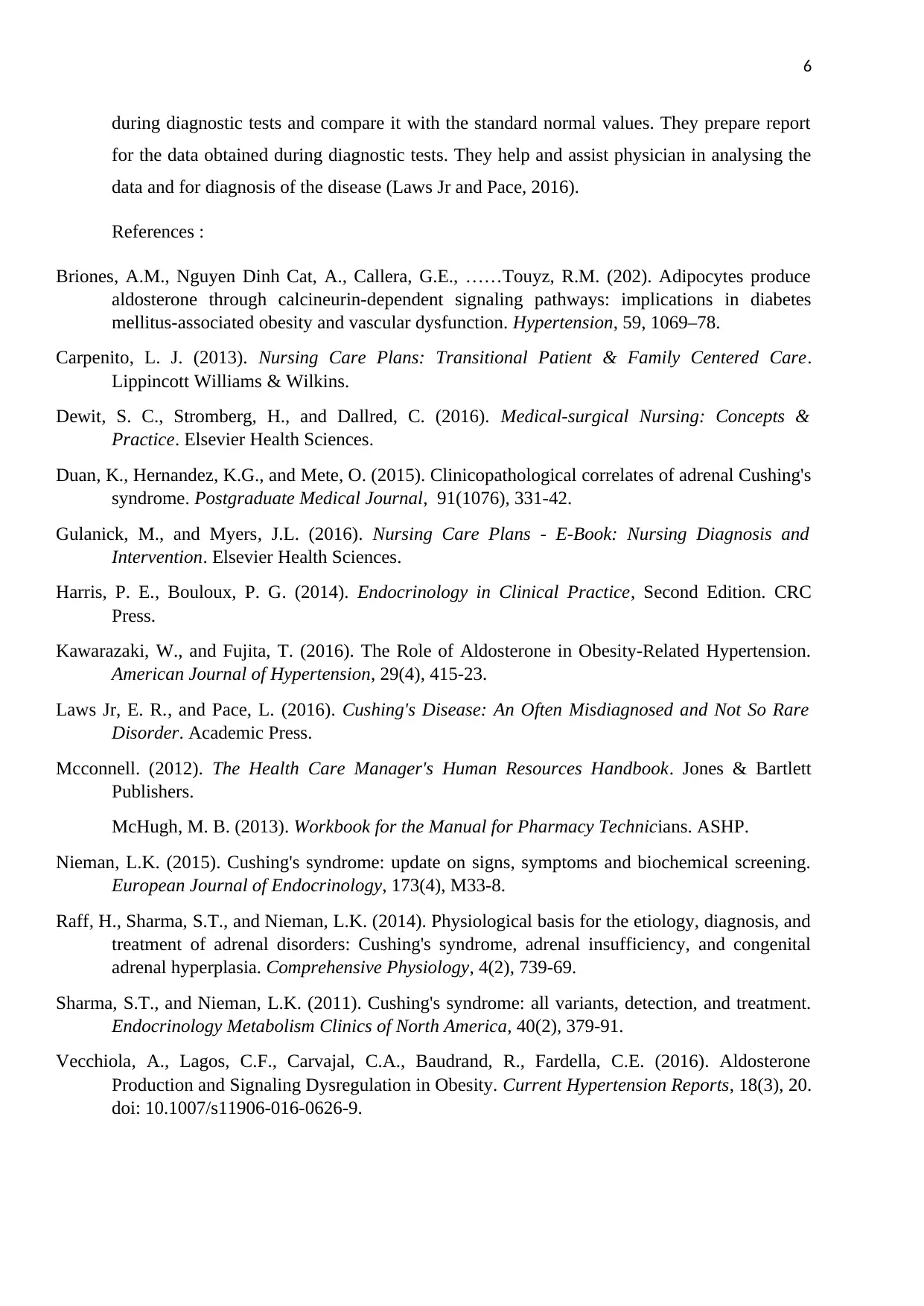
6
during diagnostic tests and compare it with the standard normal values. They prepare report
for the data obtained during diagnostic tests. They help and assist physician in analysing the
data and for diagnosis of the disease (Laws Jr and Pace, 2016).
References :
Briones, A.M., Nguyen Dinh Cat, A., Callera, G.E., ……Touyz, R.M. (202). Adipocytes produce
aldosterone through calcineurin-dependent signaling pathways: implications in diabetes
mellitus-associated obesity and vascular dysfunction. Hypertension, 59, 1069–78.
Carpenito, L. J. (2013). Nursing Care Plans: Transitional Patient & Family Centered Care.
Lippincott Williams & Wilkins.
Dewit, S. C., Stromberg, H., and Dallred, C. (2016). Medical-surgical Nursing: Concepts &
Practice. Elsevier Health Sciences.
Duan, K., Hernandez, K.G., and Mete, O. (2015). Clinicopathological correlates of adrenal Cushing's
syndrome. Postgraduate Medical Journal, 91(1076), 331-42.
Gulanick, M., and Myers, J.L. (2016). Nursing Care Plans - E-Book: Nursing Diagnosis and
Intervention. Elsevier Health Sciences.
Harris, P. E., Bouloux, P. G. (2014). Endocrinology in Clinical Practice, Second Edition. CRC
Press.
Kawarazaki, W., and Fujita, T. (2016). The Role of Aldosterone in Obesity-Related Hypertension.
American Journal of Hypertension, 29(4), 415-23.
Laws Jr, E. R., and Pace, L. (2016). Cushing's Disease: An Often Misdiagnosed and Not So Rare
Disorder. Academic Press.
Mcconnell. (2012). The Health Care Manager's Human Resources Handbook. Jones & Bartlett
Publishers.
McHugh, M. B. (2013). Workbook for the Manual for Pharmacy Technicians. ASHP.
Nieman, L.K. (2015). Cushing's syndrome: update on signs, symptoms and biochemical screening.
European Journal of Endocrinology, 173(4), M33-8.
Raff, H., Sharma, S.T., and Nieman, L.K. (2014). Physiological basis for the etiology, diagnosis, and
treatment of adrenal disorders: Cushing's syndrome, adrenal insufficiency, and congenital
adrenal hyperplasia. Comprehensive Physiology, 4(2), 739-69.
Sharma, S.T., and Nieman, L.K. (2011). Cushing's syndrome: all variants, detection, and treatment.
Endocrinology Metabolism Clinics of North America, 40(2), 379-91.
Vecchiola, A., Lagos, C.F., Carvajal, C.A., Baudrand, R., Fardella, C.E. (2016). Aldosterone
Production and Signaling Dysregulation in Obesity. Current Hypertension Reports, 18(3), 20.
doi: 10.1007/s11906-016-0626-9.
during diagnostic tests and compare it with the standard normal values. They prepare report
for the data obtained during diagnostic tests. They help and assist physician in analysing the
data and for diagnosis of the disease (Laws Jr and Pace, 2016).
References :
Briones, A.M., Nguyen Dinh Cat, A., Callera, G.E., ……Touyz, R.M. (202). Adipocytes produce
aldosterone through calcineurin-dependent signaling pathways: implications in diabetes
mellitus-associated obesity and vascular dysfunction. Hypertension, 59, 1069–78.
Carpenito, L. J. (2013). Nursing Care Plans: Transitional Patient & Family Centered Care.
Lippincott Williams & Wilkins.
Dewit, S. C., Stromberg, H., and Dallred, C. (2016). Medical-surgical Nursing: Concepts &
Practice. Elsevier Health Sciences.
Duan, K., Hernandez, K.G., and Mete, O. (2015). Clinicopathological correlates of adrenal Cushing's
syndrome. Postgraduate Medical Journal, 91(1076), 331-42.
Gulanick, M., and Myers, J.L. (2016). Nursing Care Plans - E-Book: Nursing Diagnosis and
Intervention. Elsevier Health Sciences.
Harris, P. E., Bouloux, P. G. (2014). Endocrinology in Clinical Practice, Second Edition. CRC
Press.
Kawarazaki, W., and Fujita, T. (2016). The Role of Aldosterone in Obesity-Related Hypertension.
American Journal of Hypertension, 29(4), 415-23.
Laws Jr, E. R., and Pace, L. (2016). Cushing's Disease: An Often Misdiagnosed and Not So Rare
Disorder. Academic Press.
Mcconnell. (2012). The Health Care Manager's Human Resources Handbook. Jones & Bartlett
Publishers.
McHugh, M. B. (2013). Workbook for the Manual for Pharmacy Technicians. ASHP.
Nieman, L.K. (2015). Cushing's syndrome: update on signs, symptoms and biochemical screening.
European Journal of Endocrinology, 173(4), M33-8.
Raff, H., Sharma, S.T., and Nieman, L.K. (2014). Physiological basis for the etiology, diagnosis, and
treatment of adrenal disorders: Cushing's syndrome, adrenal insufficiency, and congenital
adrenal hyperplasia. Comprehensive Physiology, 4(2), 739-69.
Sharma, S.T., and Nieman, L.K. (2011). Cushing's syndrome: all variants, detection, and treatment.
Endocrinology Metabolism Clinics of North America, 40(2), 379-91.
Vecchiola, A., Lagos, C.F., Carvajal, C.A., Baudrand, R., Fardella, C.E. (2016). Aldosterone
Production and Signaling Dysregulation in Obesity. Current Hypertension Reports, 18(3), 20.
doi: 10.1007/s11906-016-0626-9.
⊘ This is a preview!⊘
Do you want full access?
Subscribe today to unlock all pages.

Trusted by 1+ million students worldwide
1 out of 6
Related Documents
Your All-in-One AI-Powered Toolkit for Academic Success.
+13062052269
info@desklib.com
Available 24*7 on WhatsApp / Email
![[object Object]](/_next/static/media/star-bottom.7253800d.svg)
Unlock your academic potential
Copyright © 2020–2025 A2Z Services. All Rights Reserved. Developed and managed by ZUCOL.





